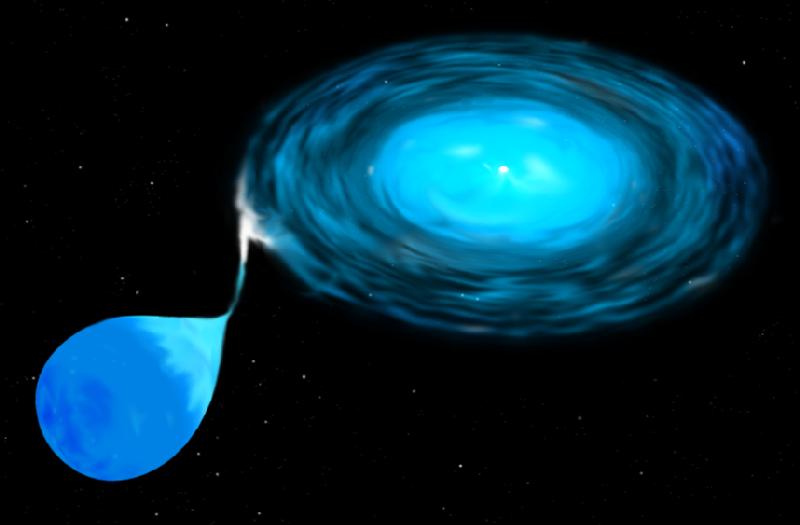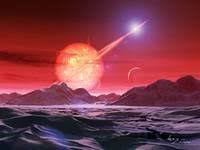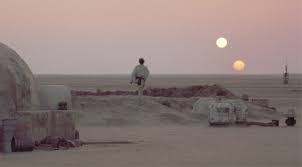By Ralph Philips. HMNS Sugarland Docent, edited by James Wooten, HMNS Astronomer
May the fourth is coming, and with it some positively stellar events hosted by the Houston Museum of Natural Science to mark the occasion. There’s the May the Fourth mixer at our Main campus, and a Stellar Wars presentation with crafts and games at our Sugar Land campus. This blog is taken from material that will be presented in HMNS Sugar Land’s stellar wars talk.
Stars come in a range of sizes, colors and family groups from lone stars like our sun to giant clusters. Of all the various groupings of stars, binary stars probably have the most complicated possibilities. A true binary star system has two stars bound together by gravity and orbiting their common center of gravity. It’s an intimate relationship, about as intimate as it gets in the cold emptiness of space, and just like couples on earth binary stars can have dysfunctional relationships. In fact, sometimes it’s all out star warfare!
Like on earth, sometimes relationship problems occur when one star matures while the other stays the same, and other times they occur when two big stars just butt heads. Stars form in a variety of sizes and colors, and often pairs of stars in a binary system may be quite different from each other.
Take a look at the chart below.
All stars shine by fusing hydrogen into helium and other light elements. The pressure generated by the nuclear furnace in the core balances the gravity pulling all of the mass towards the center. The mass of the star as it forms determines its color and size.
- Big ball of gas = big hot star (Blue)
- Small ball of gas = small cooler star (red)
Blue stars are big, bright and hot. They live fast and die young.
Yellow stars are a little smaller and live longer
Red stars are much smaller, cooler, and live a LONG time
Yellow and blue stars change as they age. When most of the hydrogen in their core is used up, the middle layers fall into the core and start to burn. When this happens, the core begins to burn hotter and starts fusing helium into carbon. Stars much more massive than our Sun will then fuse carbon into heavier elements (up to iron). The extra heat also causes the outer layers of the star to expand. The star cools and turns red. It becomes a red giant.
Eventually, the star will begin to run low on helium and one of two processes will occur, depending on the size of the star. Either the red giant will eject its outer layers, forming a planetary nebula, leaving behind a glowing core called a white dwarf, or, if the star is massive enough, the star’s core will collapse in on itself with enough force that all of the protons and electrons are crushed into neutrons. The material collapsing inward rebounds violently off this core, causing a supernova and leaving behind a super dense neutron star. Generally yellow and red (like ours) stars become white dwarfs and blue stars supernovae.
Now the stage is set for stellar warfare!!!!!
If two stars in a binary system are close enough together, and if they age at different rates and one puffs up to a red giant, mass can fall off of the bloated gas giant and onto the smaller star.
(CANNIBAL!!)
Artist’s conception of a cataclysmic variable system. Source: Wikimedia Commons.
This process accelerates the death of the larger star, eventually turning it into a white dwarf. This is called a Cataclysmic Variable System. Talk about a parasitic relationship!
But don’t worry, eventually our downtrodden hero will get his (or her?) revenge because the extra heat created by the accreted ring of gas can accelerate the cannibal star’s evolution, causing it to become a red giant. When that happens, its former victim, the white dwarf, can begin accreting material from the giant’s bloated atmosphere. Vengeance is a cruel mistress…
But this isn’t the only type of dysfunctional relationship that binary stars can have.
Remember how really massive stars sometimes collapse and form a supernova and neutron stars? Well this process can have some interesting results.
Neutron stars spin fast, up to one thousand times a second. They also have super strong magnetic fields, like orders of magnitude more powerful than the earth’s magnetic field. The gravitational field at the surface of a neutron star is about 2×1011 (200 billion) times stronger than on Earth. They are also super dense; neutron stars can have up to three times the mass of our sun crushed down to the size of New York City. A sugar cube sized sample of a neutron star’s material weighs as much a mountain. As they spin they create jets of particles beaming off the poles of the star. Those beams sweep across the sky as powerful beacons of light, particles, and radio energy.
If one of the binary stars becomes a neutron star, it will have a similar cannibal effect as that of a dwarf star, with the added annoyance of buffeting its partner with beams of gamma and radio waves.
But if both stars become neutron stars, then something pretty crazy can occur.
Two Neutron stars in orbit around each other will eventually move closer and closer together until they collide and may form a black hole.
When they collide the space around them vibrates and warps sending out gravitational waves that bend and warp space as they travel
Just 2 years ago, we were able to detect gravity waves from a neutron start merger for the first time. We now have 3 confirmed signals.
Why do they collide?
- Einstein’s equations of gravity and space predict that very massive objects exert gravity by bending the space around them.
- The “gravity well” of two massive objects (neutron stars) orbiting each other will overlap and cause the objects to gradually move closer together.
- As they get closer, they lose orbital energy by giving off gravity waves that travel through space like waves in the ocean.
I’ve heard of destructive relationships, but the end result of binary neutron star relationships pretty much takes the cake. Not only do they destroy each other, they literally collapse into a mass of gravity that destroys anyone who comes near!
Finally, we have everyone’s worst nightmare.
If the core of a star is more than three times the mass of our sun, its gravity is so strong that when it collapses it does something even crazier than creating a Neutron star. Everything is compressed into a single point with gravity so great that even light cannot escape.
Black Hole!!
In a binary system, the black hole sucks matter off the remaining star and creates a powerful jet of plasma that shoots off into space. . These jets move FAST… at up to 80% the speed of light. This is a parasitic relationship without even the hope of future vengeance
Living on a planet in a Binary Sun System may look cool in art
BUT
You might want to move before the fireworks start !!!!
What sunset may look like on a planet orbiting an old Binary System
Luckily for Luke, none of the scenarios discussed in this blog are happening to the Binary System that Tatooine orbits













